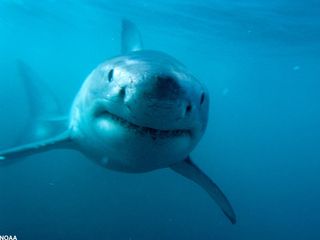Great White Lies About Great White Sharks

Another swimmer was killed by a shark off the Pacific coast of Mexico on May 24, the second tragic shark encounter in two months in that area, thus officially launching another summer of shark hysteria. The Mexican Navy immediately took to seas to search for the sharks, perhaps with the intent to punish them or at least send a stern warning to the shark community. Shark reports are now a regular feature of the news as far away as the New England coast; the sharks are tracked as if they are as deadly as a tornado or summer storm. What would be the reaction to the death of a kid in Iowa killed by a bee sting? Imagine the drama unfold as angry and nervous denizens take to the fields with insect repellent. Never mind pollination: The bees must die. And why not? Worldwide bees are nearly a hundred times deadlier than sharks, killing about 500 people annually, including about 50 in the United States, according to the Centers for Disease Control and Prevention. Yes, sharks are deadly. It has something to do with their gazillion or so razor-sharp teeth. But while it is prudent to avoid waters populated with sharks, shark encounters are rare and fatalities from attacks are even rarer. The number of shark attacks averages about 65 worldwide annually, according to the International Shark Attack File at the University of Florida. Expect about 30 attacks in U.S. waters, mostly near Florida. In 2007 there was only one death, way over in New Caledonia in the South Pacific. Two deaths near Mexico is a bad start to the summer season, when folks are most likely to be in the water, but this might not challenge the annual average of five to ten deaths. Deadlier than sharks, with wings or collars So which animals should you really avoid? Many consider the mosquito to be the deadliest animal on earth, because it is responsible for malaria, yellow fever, dengue fever and many other diseases, killing millions of people each year. Technically, though, it is not the mosquito but the parasite or virus it is carrying in its gut — protozoan parasites, for malaria — that causes the disease. Snakes are the most dangerous land animals, killing tens of thousands people a year worldwide. Deadly snake bites are rare in the United States, but snakes still edge out sharks, responsible for five or ten deaths a year, largely in the Southwest. Tens of thousands more people are killed by scorpions and venomous spiders — but again, no spider-citing report, no film at 11. Along with those treacherous bees, dogs top the list of killers in the United States. Through the 1980s and until 1995 — the last year of official statistics — the CDC was recording nearly 20 deaths per year, almost entirely from pit bulls and rottweilers. Call of the wild In the jungle, the mighty jungle, the lion sleeps while crocodiles kill about 2,000 humans each year. Elephants and hippos each kill hundreds more, largely by trampling the unsuspecting victim surprised by these animals' speed. In the ocean, fear jellyfish more than sharks. In particularly, that's the box jellyfish family of about 20 species, which live in tropical waters. Their venom is the deadliest among animals, and they are responsible for about 100 human deaths per year. The sting from a Portuguese Man o' War — confused for a jellyfish, technically a colony of sea polyps — also can be deadly but mostly just hurts a lot. Jaws, the reality There's a simple reason why sharks don't attack humans repetitively, unlike what you saw in the movie "Jaws:" Humans don't taste good. Sharks prefer blubber. Shark teeth are lined with nerve endings that can sense the calorie-rich blubber of a seal as opposed to the bone and muscle filling most humans. The only problem is that sharks sample by biting. Most people will survive a shark bite, but it can be debilitating nonetheless. Serious surfers are at greatest risk, comprising the majority of shark-attack cases. Most of us in the water, with blubber or not, are safe.
- Shark Jobs: Nature's Dirty Work
- Sharks Everywhere: Vote for Your Favorite
- Top 10 Deadliest Animals
Sign up for the Live Science daily newsletter now
Get the world’s most fascinating discoveries delivered straight to your inbox.

Christopher Wanjek is a Live Science contributor and a health and science writer. He is the author of three science books: Spacefarers (2020), Food at Work (2005) and Bad Medicine (2003). His "Food at Work" book and project, concerning workers' health, safety and productivity, was commissioned by the U.N.'s International Labor Organization. For Live Science, Christopher covers public health, nutrition and biology, and he has written extensively for The Washington Post and Sky & Telescope among others, as well as for the NASA Goddard Space Flight Center, where he was a senior writer. Christopher holds a Master of Health degree from Harvard School of Public Health and a degree in journalism from Temple University.
Most Popular



